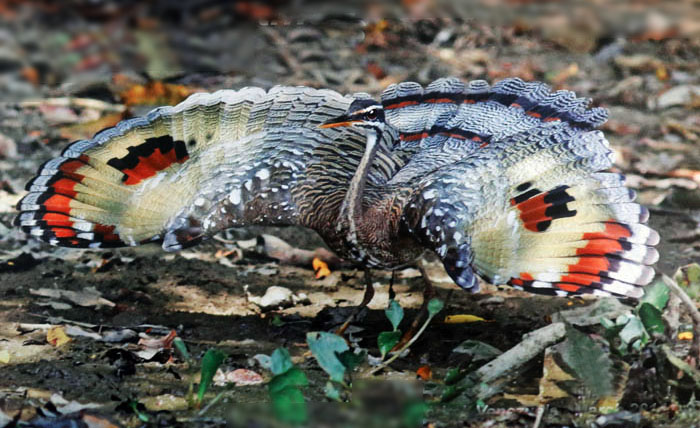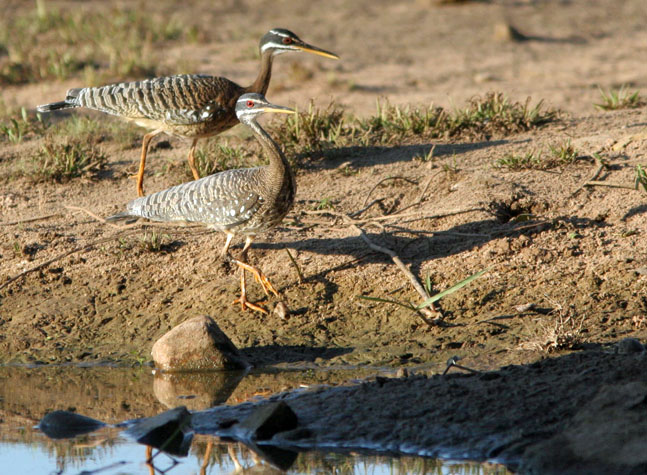
a web page by Don Roberson |
SUNBITTERN Eurypygidae |
|
In the Venezuelan llanos and Brazilian Pantanal, however, sunbitterns are more easily found out in the open, hunting along the edges of drying up ponds, but still tending to stick to the shade and nearby cover (the pair at left were in the Brazilian Pantanal). Along these edges it uses binocular vision to search methodically for frogs and insects. The handsomely patterned Sunbittern looks a bit like a horizontal heron. It has a fairly long, straight bill; a long slender neck; a long protruding tail; and short legs used for stalking waterside prey. |
| Sunbittern is generally a cryptic bird, but hidden in the wings are two enormous bright "eyes" or "sunspots" that are used both in display, and to startle potential predators (below; a wonderful shot by the late, great David Fisher). |
 |
There are no fossils of sunbitterns, and their taxonomic position has been the subject of some debate. Morphological and behavioral characteristics are shared with the Kagu of New Caledonia (and egg-white protein analysis implies affinities there). In addition, the spectacular (and usually hidden) patterns in the wings are shared by the Kagu and Sunbittern. Some theorized that both may have originated from the Mesozoic biota of Gondwanaland (e.g., summary in Thomas 1996). Molecular analysis in this century does not fully support the Gondwanaland theory, but does place both the Sunbittern and Kagu outside the core Gruiformes with which it had traditionally been placed (e.g., Fain & Houde 2004, Hackett et al. 2008). Ericson et al. (2006) used molecular dating to trace the sunbittern-kagu ancestors back 60 million years to the Paleocene, with divergence during the Oligocene. Currently, the Eurypygidae is thought to be sister to the Kagu [Rhynochetidae], and these two families together now comprise the Eurypygiformes (Hackett et al. 2008, Suh et al. 2015). |
Photos: The pair of Sunbittern Eurypyga helias was in the Pantanal of Mato Grosso, Brazil, on 23 July 2010; the bottom photo of a single bird was also taken 11 years earlier, in July 1999. David Fisher took the photo of a Sunbittern in display at Hato Cedral, Venezuela, in March 2014. All photos © Don Roberson, except the photo credited to David Fisher, and used with permission; all rights reserved. Bibliographic note: There is no "family book" but a fine introduction, with some good photos, is in Thomas (1996). Literature cited:
|
 The Sunbittern is a wonderful water-edge bird of the Neotropics, ranging from Guatemala to the Pantanal of southern Brazil and Paraguay. In heavily forested country, such as Central America or the Amazon basin, it can be difficult to locate and approach as it hunts along clear streams and rivers. A group of us found it in Panama, for example, by wading up a small crystal-clear stream that crossed Pipeline Road until we flushed one from the bank.
The Sunbittern is a wonderful water-edge bird of the Neotropics, ranging from Guatemala to the Pantanal of southern Brazil and Paraguay. In heavily forested country, such as Central America or the Amazon basin, it can be difficult to locate and approach as it hunts along clear streams and rivers. A group of us found it in Panama, for example, by wading up a small crystal-clear stream that crossed Pipeline Road until we flushed one from the bank.  Sunbittern can be a patient hunter. Here (right) one stands quietly with a cryptic reflection in a quiet, shadowy pool. At one time there were thought to be two species of sunbittern: the nominate helias in the Amazon basin and major of Central America to coastal Ecuador. Today, these taxa (plus the lower subtropical race meridionalis in central Peru) are considered subspecies of a single widespread species. It was once thought that Sunbittern's range extended to Mexico, but documentation is absent and there are no recent reports (Howell & Webb 1995).
Sunbittern can be a patient hunter. Here (right) one stands quietly with a cryptic reflection in a quiet, shadowy pool. At one time there were thought to be two species of sunbittern: the nominate helias in the Amazon basin and major of Central America to coastal Ecuador. Today, these taxa (plus the lower subtropical race meridionalis in central Peru) are considered subspecies of a single widespread species. It was once thought that Sunbittern's range extended to Mexico, but documentation is absent and there are no recent reports (Howell & Webb 1995).